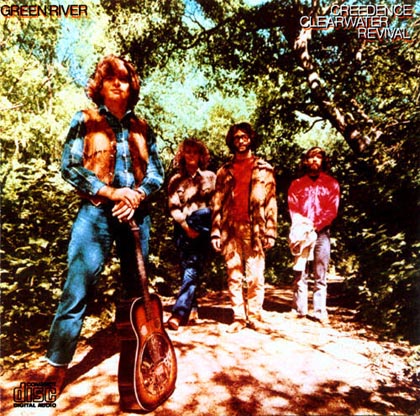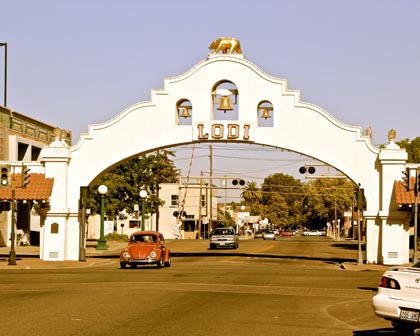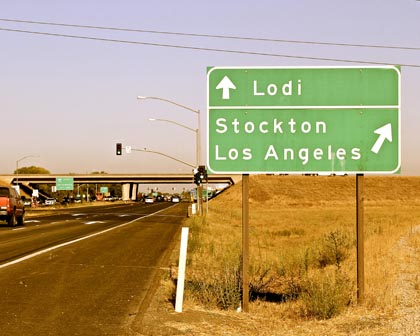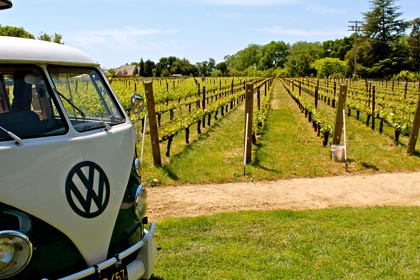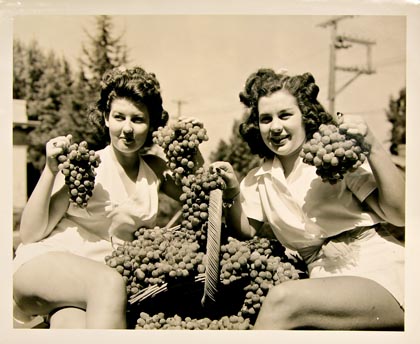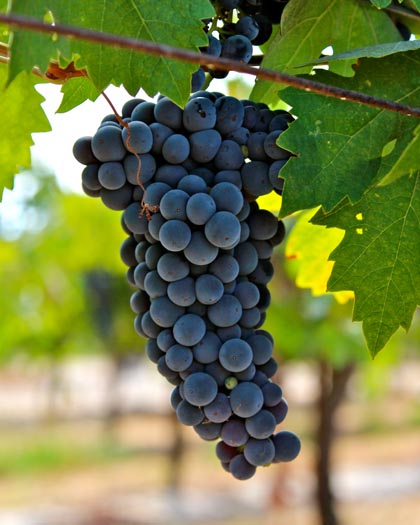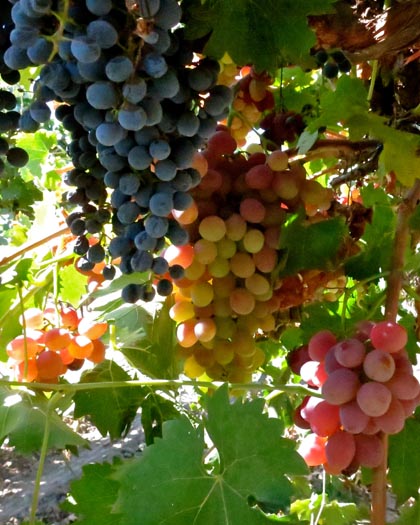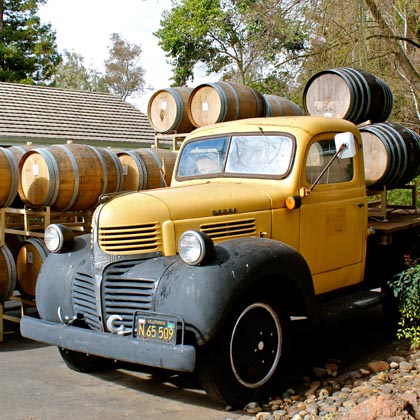Letters from Lodi
An insightful and objective look at viticulture and winemaking from the Lodi
Appellation and the growers and vintners behind these crafts. Told from the
perspective of multi-award winning wine journalist, Randy Caparoso.
John Fogerty never slept here (101 grapes & other lesser known facts about Lodi)
“Lodi” was also on Creedance Clearwater Revival’s 1969 Green River album
Oh, lord…
Although it was the "B" side of Creedence Clearwater Revival's 1969 single record, "Bad Moon Rising" (which peaked at No. 52 on the Top 100 singles charts), in many ways the song "Lodi" has endured as one of the group's catchiest, most memorable tunes – its story line (being "stuck" in a nowheresville town), one that almost anyone can identify with.
But it was never a true story.
As it turns out, CCR's founding leader and songwriter, John Fogerty, never actually slept, or got stuck, in Lodi. As far as anyone knows, he still hasn't, to this day. So why did he write his famous song about "Lodi?" According to Fogerty himself, communicating with fans on credence-online.net, "The first time I ever heard the word 'Lodi,' I thought it was the coolest sounding name, so I saved it for the longest time."
Lodi
Fogerty went on to explain: "I sat down and wrote about being on the road, being a musician — not the happy, glamorous part. Rather, I projected myself ahead maybe 10 years, as a country musician singing that minor hit I had 10 years ago. There I was… I wasn't in Los Angeles, not even in Cucamonga. I'm way out in Lodi! The song went from 'Lodi' to 'Oh Lord, stuck in Lodi, again,' not a happy thought."
Imagine if Cucamonga had fit in better with the song's meter – folks in Cucamonga would have had that classic road song written about their town, not Lodi. As it were, Lodi sounded much better, even though Lodi never has been a true hole-in-a-wall. If anything, Lodi has been very much an attractive, even romantic, wine country destination; especially in recent years.
Technically, Lodi has been an incorporated city since 1906, with a current population of over 63,000 (according to the 2013 Census Bureau). In 1970, a year after CCR's single hit the airwaves, Lodi's population was about 28,000. Despite being the center of a farming community – a smartly preserved green belt sandwiched between Stockton to the south and Sacramento to the north – the City of Lodi has enjoyed a steady, controlled pattern of growth each and every year since 1910 (when its population was 2,697).
This way to Lodi
What else is often misconstrued about Lodi? Among wine lovers, Lodi – which became an official American Viticultural Area (i.e. AVA) in 1986 – is often thought to be a hot, desert-like region because of its location in the center of California's Central Valley. This certainly may be a little true of the Central Valley's southern reaches, between Fresno and Bakersfield. But it is not true of Lodi, which is located at the mouth of the Sacramento-San Joaquin Delta: a complex network of marshy channels, sloughs and islands where fresh river waters merge with Pacific tidewaters from Suisun Bay, San Pablo Bay, and upper San Francisco Bay, reverse-funneling cool, moderate air throughout a mildly warm growing season.
In fact, Lodi's climate is classified as dry-summer subtropical Mediterranean: similar to the wine countries in the vicinity of the Mediterranean Basin (especially Spain, Southern France, Italy and Greece), where viticulture and winemaking are thought to have originated thousands of years ago; and also similar to coastal regions such as Napa Valley, Sonoma County, Paso Robles and Santa Barbara, all considered "Mediterranean."
Lodi vineyard
What else is unique about Lodi as a wine region? Here are a few more tidbits about this AVA that you may find interesting:
- Lodi is America's most widely planted AVA, with currently over 113,000 acres of wine grapes in the ground. Table grapes and raisins – major crops in the southern half of the Central Valley – are not cultivated in Lodi. It's all about vino here in the Delta.
- The Lodi AVA's boundaries encompass 644,500 acres in North San Joaquin County (overlapping into Sacramento County to the north). However, the Lodi AVA is actually puny compared to, say, the Ohio River Valley AVA (which has over 16 million acres in Indiana, Kentucky, Ohio and West Virginia) or the Columbia Valley AVA (over 11 million acres, mostly in Washington, overlapping slightly into Oregon). Nevertheless, Lodi's planted wine grape acreage is larger than Ohio River Valley's (about 42,000 acres planted in this AVA), and far more extensive than Columbia Valley's (less than 7,000 acres). In comparison to Lodi's 113,000 acres, there are approximately 43,000 acres planted in Napa Valley, and just over 60,000 acres in all of Sonoma County.
- Lodi is closely identified with Zinfandel; a grape of Croatian origins, probably first planted in the region by George and William West (who founded El Pinal Winery) during either the late 1850s or early 1860s. There are just over 19,000 acres of Zinfandel planted in Lodi (slightly less than 37% of the total Zinfandel acreage in California). By comparison, there are just over 5,300 acres of Zinfandel planted Sonoma County, just over 2,000 acres in Amador County, and less than 1,500 acres remaining in Napa Valley.
- There are over 12,000 acres of Cabernet Sauvignon – California's most widely planted red wine grape (over 86,000 acres total) – planted in Lodi. This is less than in Napa Valley (nearly 20,000 acres), and a smidgen more than Sonoma County (just under 12,000 acres). But obviously, there aren't nearly as many brands of Cabernet Sauvignon bottled with Lodi on the label as Napa Valley or Sonoma. So where does it all go? Much of it, undoubtedly, goes into wines bottled as "California Cabernet Sauvignon," although state law also allow up to 15% leeway in wines carrying regional designations. Hence the old joke, "there is a lot of Napa Valley Cabernet Sauvignon (and Chardonnay) grown in Lodi" – and in fact, Lodi has traditionally played the important role of helping to fill out premium wines in all parts of the state.
Lodi Tokay grape queens, 1941
Finally, there are unusual and interesting wine grapes grown in seemingly every wine region in the U.S. Lodi has its share – in fact, probably more than anywhere else in the world. In our last grape consensus, we've counted over 100. Lodi's huge variety of wine grapes may be another lesser known fact about the wine region; but it is one which more and more consumers, in search of new and exciting wines, are discovering, and enjoying, everyday.
Among the 100-plus wine grapes cultivated in Lodi:
- Aglianico
- Albariño
- Alicante Bouschet
- Albalonga
- Alvarelhão
- Arnsburger
- Bacchus
- Barbera
- Bastardo (a.k.a. Trousseau Noir)
- Black Prince (a.k.a. Black Muscat)
- Blauer Portugieser
- Blaufränkisch (a.k.a. Lemberger)
- Cabernet Franc
- Cabernet Sauvignon
- Carignan
- Carmine
- Chardonnay
- Chasselas (a.k.a. Gutedel)
- Chenin Blanc
- Cinsaut
- Colombard (a.k.a. French Colombard)
- Counoise
- Dolcetto
- Dornfelder
- Ehrenfelser
- Faberrebe
- Forta
- Früeburgunder (a.k.a. Pinot Noir Précoce)
- Gewürztraminer
- Graciano
- Green Hungarian (a.k.a. Butschera)
- Grenache
- Grenache Blanc
- Grignolino
- Grüner Veltliner
- Huxelrebe
- Kanzler
- Kerner
- Malbec
- Malvasia
- Marsanne
- Marzemino
- Merlot
- Mission
- Montepulciano
- Morio Muscat
- Moscato Giallo (a.k.a. Yellow Muscat)
- Mourvèdre
- Müller-Thurgau
- Muscat Canelli (a.k.a. Muscat Blanc)
- Muscat Orange
- Nebbiolo
- Noblessa
- Optima
- Oraniensteiner
- Perle
- Petit Verdot
- Petite Sirah (a.k.a. Durif)
- Pinotage
- Pinot Blanc
- Pinot Gris (a.k.a. Pinot Grigio)
- Pinot Meunier
- Pinot Noir
- Piquepoul
- Primitivo
- Rieslaner
- Riesling
- Regent
- Rotberger
- Roter Veltliner
- Roussanne
- Sangiovese
- Sauvignon Blanc
- Scheurebe
- Schönburger
- Sémillon
- Sirius
- Siegerrebe
- Silvaner
- Souzão
- Saint-Macaire
- St. Laurent
- Symphony
- Syrah
- Tannat
- Tempranillo
- Teroldego
- Tinta Cão
- Tokay (a.k.a. Flame Tokay)
- Torrontés
- Touriga Franca (a.k.a. Touriga Francesa)
- Touriga Nacional
- Trincadeira (a.k.a. Tinta Amarela)
- Trollinger
- Verdejo
- Verdelho
- Vermentino
- Viognier
- Würzer
- Zinfandel
- Zweigelt
Lodi keeps on truckin’!
